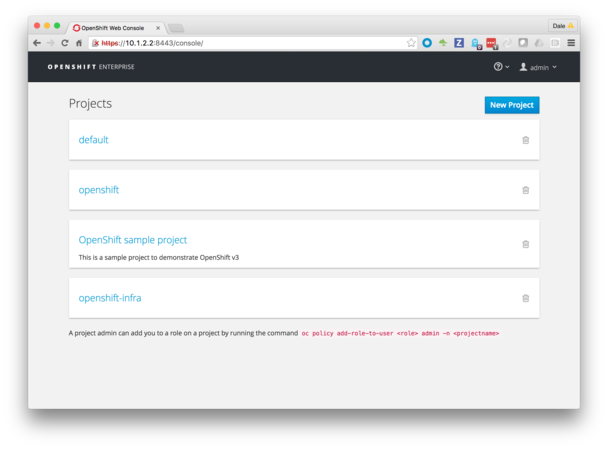June 16, 2016
The RedHat Container Developer Kit allows you to deploy OpenShift on your laptop for easier testing and development. Here is how to deploy it.
Register as a RedHat Developer
Place credentials in
~/.vagrant.d/Vagrantfileto enable updates for VMs by automatically registering with RedHat Subscription Manager
Vagrant.configure('2') do |config|
config.registration.username = '<your Red Hat username>'
config.registration.password = '<your Red Hat password>'
end
Mac OS X Prereqs
Install pre-reqs:
Download the Vagrant Box from here to
~/Downloads
RedHat Container Developer Kit Setup
Download Red Hat Container Developer Kit
cdk-2.0.0.zipfrom here and unzip to~/cdk.Follow the Install Docs to:
- Install vagrant plugins
cd ~/cdk/plugins vagrant plugin install *.gem- Import the vagrant box to
~/.vagrant.d/boxes/
vagrant box add --name cdkv2 ~/Downloads/rhel-cdk-kubernetes-7.2*.x86_64.vagrant-virtualbox.box- Remove
~/Downloads/rhel-cdk-kubernetes-7.2*.x86_64.vagrant-virtualbox.box
Getting Started
- Start CDK and print helpful environment info
cd ~/cdk/components/rhel/rhel-ose/
vagrant up
vagrant provision
Access the console at https://10.1.2.2:8443/console using a credential below:
- User: openshift-dev Pass: devel
- User: admin Pass: admin
If you forget where to find the console vagrant can remind you
cd ~/cdk/components/rhel/rhel-ose/
vagrant service-manager env openshift
- Curl the sample app that ships in the CDK
curl http://helloflask-sample-project.rhel-cdk.10.1.2.2.xip.io/api
How the heck did that work?! Checkout xip.io.
- SSH to your openshift VM and list the openshift images
cd ~/cdk/components/rhel/rhel-ose/
vagrant ssh
[vagrant@rhel-cdk ~]$ docker search registry.access.redhat.com/openshift3
INDEX NAME DESCRIPTION STARS OFFICIAL AUTOMATED
redhat.com registry.access.redhat.com/openshift3/image-inspector Image Inspector can extract the RPM compos... 0
redhat.com registry.access.redhat.com/openshift3/jenkins-1-rhel7 Jenkins image which can be used to set up ... 0
redhat.com registry.access.redhat.com/openshift3/logging-auth-proxy Container used to enable authorization and... 0
...
- Try each of these
$ docker search registry.access.redhat.com/rhscl
$ docker search registry.access.redhat.com/openshift3
$ docker search registry.access.redhat.com/rhel
$ docker search registry.access.redhat.com/jboss
Neat hu?
Updating CDK
CDK 2.1 is out now with OpenShift Enterprise 3.2. Let’s update!
- Download Red Hat Container Developer Kit
cdk-2.1.0.zipfrom here and unzip to~/cdk-2.1.
mv ~/cdk ~/cdk-2.0
ln -s ~/cdk-2.1 ~/cdk
- Update Vagrant Plugins
$ cd ~/cdk/plugins
$ vagrant plugin list
landrush (0.15.3)
vagrant-dnsmasq (0.1.1)
vagrant-hostmanager (1.6.0)
vagrant-registration (1.2.1)
- Version Constraint: 1.2.1
vagrant-service-manager (1.0.1)
- Version Constraint: 1.0.1
vagrant-share (1.1.4, system)
vagrant-sshfs (1.1.0)
- Version Constraint: 1.1.0
$ ls *gem
vagrant-registration-1.2.2.gem vagrant-service-manager-1.1.0.gem vagrant-sshfs-1.1.0.gem
$ vagrant plugin install vagrant-registration-1.2.2.gem
Installing the 'vagrant-registration-1.2.2.gem' plugin. This can take a few minutes...
Installed the plugin 'vagrant-registration (1.2.2)'!
Download the latest Red Hat Enterprise Linux 7.2 Vagrant box for VirtualBox
Update the vagrant box This will replace your current environment, so modify if you with to keep the 2.0 environment around!
$ vagrant box add --force --name cdkv2 rhel-cdk-kubernetes-7.2*.x86_64.vagrant-virtualbox.box
Now go back to Getting Started and fire up your new CDK 2.1 VM.
More Info
Check out my post on deploying metrics to CDK.


